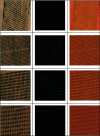A Large-Scale Dataset and Deep Learning Model for Detecting and Counting Olive Trees in Satellite Imagery
- PMID: 35075356
- PMCID: PMC8783740
- DOI: 10.1155/2022/1549842
A Large-Scale Dataset and Deep Learning Model for Detecting and Counting Olive Trees in Satellite Imagery
Abstract
Since the Pre-Roman era, olive trees have a significant economic and cultural value. In 2019, the Al-Jouf region, in the north of the Kingdom of Saudi Arabia, gained a global presence by entering the Guinness World Records, with the largest number of olive trees in the world. Olive tree detecting and counting from a given satellite image are a significant and difficult computer vision problem. Because olive farms are spread out over a large area, manually counting the trees is impossible. Moreover, accurate automatic detection and counting of olive trees in satellite images have many challenges such as scale variations, weather changes, perspective distortions, and orientation changes. Another problem is the lack of a standard database of olive trees available for deep learning applications. To address these problems, we first build a large-scale olive dataset dedicated to deep learning research and applications. The dataset consists of 230 RGB images collected over the territory of Al-Jouf, KSA. We then propose an efficient deep learning model (SwinTUnet) for detecting and counting olive trees from satellite imagery. The proposed SwinTUnet is a Unet-like network which consists of an encoder, a decoder, and skip connections. Swin Transformer block is the fundamental unit of SwinTUnet to learn local and global semantic information. The results of an experimental study on the proposed dataset show that the SwinTUnet model outperforms the related studies in terms of overall detection with a 0.94% estimation error.
Copyright © 2022 Amr Abozeid et al.
Conflict of interest statement
The authors declare that they have no conflicts of interest to report regarding the present study.
Figures




References
-
- Waleed M., Um T.-W., Khan A., Ahmad Z. An automated method for detection and enumeration of olive trees through remote sensing. IEEE Access . 2020;8:108592–1085601. doi: 10.1109/access.2020.2999078. - DOI
-
- Gao G., Liu Q., Wang Y., Sensing R. Counting from sky: a large-scale data set for remote sensing object counting and a benchmark method. IEEE Transactions on Geoscience and Remote Sensing . 2020;59(5):3642–3655. doi: 10.1109/TGRS.2020.3020555. - DOI
-
- Gao G., Liu Q., Wen Q., Wang Y. PSCNet: Pyramidal Scale and Global Context Guided Network for Crowd Counting. 2020. https://arxiv.org/abs/2012.03597 .
-
- Eldahshan K., Farouk H., Abozeid A., Eissa M., Technology A. I. Global dominant SIFT for video indexing and retrieval. Journal of Theoretical and Applied Information Technology . 2019;97(19)
-
- Dalal N., Triggs B. Histograms of oriented gradients for human detection. Proceedings of the 2005 IEEE computer society conference on computer vision and pattern recognition, (CVPR’05); July, 2005; IEEE, San Diego, CA, USA. pp. 886–893. - DOI
MeSH terms
LinkOut - more resources
Full Text Sources

